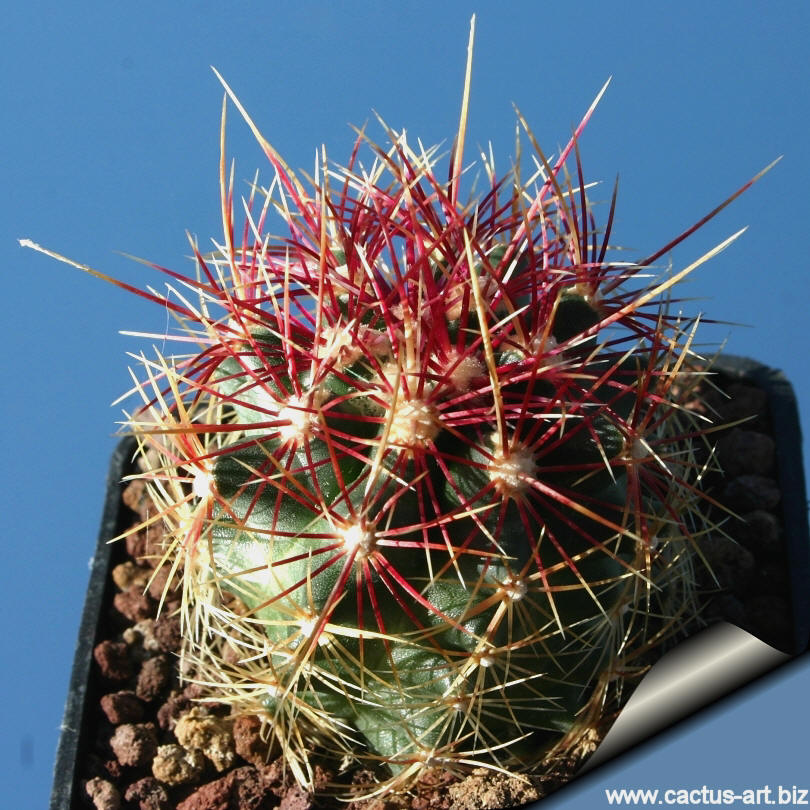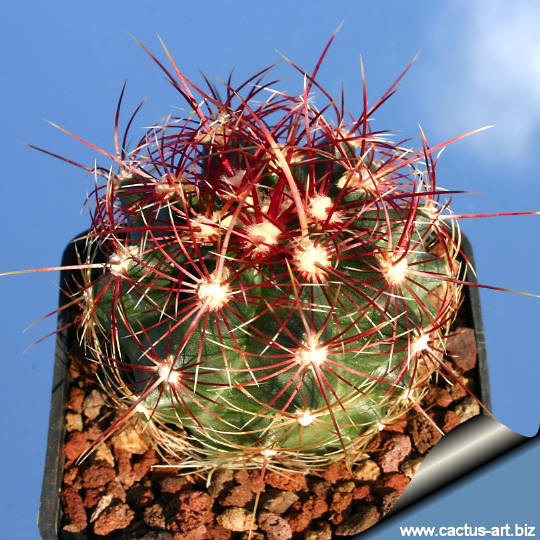|
|
|

Thelocactus bicolor
var.
schottii
|
|
Description:
Usually solitary cactus that are
sometime branched from their base, globular, egg-shaped, conical to
almost columnar-shaped, attaining a maximum height of 25 cm and
up to 12 cm in diameter, but mostly smaller. The epithet "schottii"
has been applied to the plants which are characterized by
bearing (in mature specimens) a very long, flattened, papery upper spine
up to 7 cm long, not, has been asserted, in its having a greater number
of radial spines. No other differences have been reported, so that, this
entity should be (probably) added to the synonymy of "bicolor".
Stem: Ovoidal, 8-20 cm tall, 5-12 cm wide.
Ribs: ± 8, distinct. Tubercles square-based rounded.
Areoles: With glands.
Central spines: 1, 75-90 mm long, red, flattened, papery.
Radial spines: 8-18, 25-60 mm long, ochre to reddish, straight,
acicular.
Flowers: 55-110 mm wide, Petals are recurved, glossy intensely
magenta (or rarely pink or red) with a red throat.
Blooming season: From early spring to summer. The blooms expand
only in the afternoon of brilliant sunny days when temperatures are
extremely hight. three or fours hours later, when light begins to wane,
they close forever
Fruit: 10-20 mm long.
|
|
Cultivars:
Thelocactus bicolor cv. INERMIS
Cultivation: It is a summer grower species
easy to cultivate. Water regularly from Spring to Autumn, but do not
overwater, can become too elongated if compost is too rich. Requires
full sun or light shade and careful watering to keep plant compact with
strong coloured spines. Needs good drainage and very porous potting mix,
In Winter, keep dry.
Reproduction: From seed,
since the plant rarely produces plantlets.
|
|


Advertising
|
|
|
|
Family:
Cactaceae (Cactus
Family)
|
|
Scientific name:
Thelocactus
bicolor (Galeotti ex
N.E. Pfeiffer) Britt. & Rose var. schottii (Engelm.)
Krainz,
In: Die Kakteen, Lfg.
18 (1961)
Origin: Endemic
from the Big Bend of the Trans
Pecos, Texas, USA
Conservation status: Listed in
CITES appendix 2.
Common English Names include:
Glory of Texas
|
Synonyms:
- Thelocactus bicolor
var. schottii Krainz
- Echinocactus bicolor
var. schottii Engelm.
In: Proc. Amer.
Acad. 3: 277 (preprint 1856).
- Echinocactus
schottii Small
In: Fl. Southeast U.
S. 814 (1903)
- Thelocactus bicolor
schottii Davis ex Backeb.
In: Die Cactacecae
V: 2809 (1961), nom. inval.
- Thelocactus schottii (Engelmann) Kladiwa & Fittkau
Published in: Krainz, Die Kakteen. CVIII b. 1. IV. (1975)

|
|
|
|
Photo of conspecific taxa,
varieties, forms and of
plants belonging to the Thelocactus
bicolor
complex
(This
Taxon has lots of
synonyms ( like many other
cacti) whit several controversial
varieties and subspecies and comprises a multitude of different
forms, but where each form is linked to others by populations of plants
with intermediate characteristics):
- T.
bicolor var. bicolor (Frost hardiness -7°C )
-
T. bicolor var. bolaensis (Frost hardiness -12°C ) Origin:
Coahuilafrom Sierra Bola, up to 20 cm tall.
-
T. bicolor var. commodus It has been described as
having only one, porrect, central spine, but with a careful
observation it is possible to notice that the upper central spines are
so appressed to the stem that they can be easily mistaken for radials.
- T. bicolor var. ellipticus is
referable to bicolor.
-
T. bicolor var. flavidispinus (Frost hardiness -12°C
) Texas 8cm in diameter, 5cm tall.
-
T. bicolor var. heterochromus
-
T. bicolor var. pottsii (Referable to bicolor var.
heterochromus).
- T. bicolor var. rhodophthalmus is referable to
bicolor.
- T. bicolor var.
schottii (Frost hardiness -12°C) coming from the Big Bend
area Texas, Chihuahua) characterized by a very long, papery upper
spine.
-
T. bicolor var. schwarzii 1 0° F (-12°C) Tamaulipas
- T. bicolor var. texensis is an invalid name
for a Texas form.
- T. bicolor var. tricolor (Frost hardiness -7°C ) A
form with bright red spines. Plants with these characters can be found
around Saltillo, Coahuila.
- T. bicolor var. zwakii, It is not sufficiently
distinct to deserve a subspecies rank.
|
|